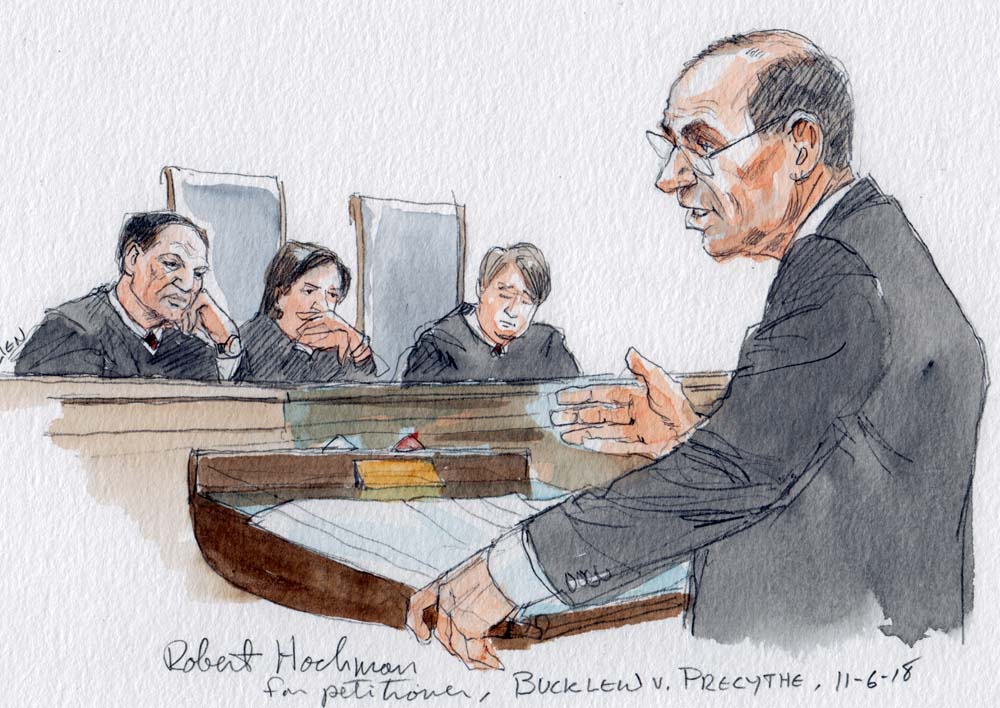Argument analysis: Relatively subdued court is divided in lethal-injection case


The Supreme Court heard oral argument this morning in the case of Russell Bucklew, who was scheduled to die by lethal injection earlier this year. The court has already rejected several broad challenges to the constitutionality of lethal injection as a method of execution, but the justices put Bucklew’s execution on hold back in March so that they could consider his argument that executing him by lethal injection would violate the Constitution’s ban on cruel and unusual punishment because, as a result of a rare medical condition, he is likely to undergo a “gruesome” and “excruciating” death even if the execution goes as planned. The justices were relatively subdued but seemed to be mostly divided along ideological lines, and it seemed very possible that the outcome could hinge on the vote of the court’s newest justice, Brett Kavanaugh, who at times appeared sympathetic to Bucklew.

Bucklew has been on death row in Missouri for 20 years for the 1996 murder of Michael Sanders, who at the time was living with Stephanie Ray, Bucklew’s former girlfriend. As part of the same series of events, Bucklew kidnapped and raped Ray, and he wounded a state trooper during a shootout. Bucklew has a condition known as cavernous hemangioma, which causes fragile blood-filled tumors to grow in his head, neck and throat.
One of the main points of contention before the court was Bucklew’s assertion that, if the state follows its lethal-injection protocol, he could wind up choking on his own blood and in extreme pain. Bucklew’s attorney, Robert Hochman, told the justices that the team carrying out the execution could have to try to administer the drug used in the lethal-injection protocol through Bucklew’s femoral vein – in essence, Hochman stressed, “carving up” Bucklew’s leg for up to 15 minutes. More broadly, Hochman complained, the execution team would not have critical information about Bucklew that would allow it to address his particular needs and potentially alleviate his pain, nor would Bucklew and his lawyers have information about the team’s training and experience. Hochman urged the court, at the very least, to invalidate the lower court’s ruling and send the case back for more fact-finding on whether the state’s lethal-injection protocol can be changed to reduce the likelihood that Bucklew will suffer.
Justice Elena Kagan asked only a few questions, but she appeared receptive to Bucklew’s arguments. She observed that the court’s earlier opinions rejecting challenges to lethal injection had emphasized the need to defer to states in determining the appropriate method of execution. But when state officials make decisions about what method of execution to use, she stressed, they are looking at the big picture and prisoners generally, rather than thinking about individual inmates. And that means, she suggested, that the state isn’t entitled to the same kind of deference here, because the state wasn’t thinking about an inmate like Bucklew.
Kavanaugh appeared concerned about the prospect that inmates like Bucklew could suffer excruciating pain as a result of the method of execution selected by the state. He asked Missouri Solicitor General John Sauer, who argued for the state, whether an execution could go forward even if would create “gruesome brutal pain.” When Sauer responded that it could, Kavanaugh pressed him to explain whether there were any limits on how much pain the execution could inflict. Sauer’s answer: Yes, an execution could not go forward if the pain were so gruesome and brutal that the state would be deliberately inflicting pain for the sake of pain.

Sauer pushed back against the idea that Bucklew was likely to suffer at all if he were executed by lethal injection, emphasizing that Bucklew has suffered from cavernous hemangioma his entire life but only raised this challenge shortly before his execution. Bucklew’s real goal in pressing this case, Sauer told the justices, is delay – indeed, this is Bucklew’s third “method of execution” challenge.
Some of the court’s more conservative justices appeared to side with the state on this issue, as well as on the second point of contention in the case: whether Bucklew needs to suggest, and has in fact offered, another method of execution that will be less painful than lethal injection. Arguing for Bucklew today, Hochman maintained that inmates must suggest an alternate method of execution only when they are arguing that a method of execution is always unconstitutional (known as a “facial” challenge), rather than arguing, as Bucklew is here, that a method of execution is unconstitutional in his particular case (known as an “as-applied” challenge). But in any event, Hochman continued, other states have adopted lethal gas – the alternative Bucklew has proposed — as a method of execution, even if there are details about lethal-gas executions to be worked out.
Justice Neil Gorsuch, who spoke up very little during the oral argument, disagreed with Hochman. When it comes to suggesting an alternative method of execution, he asked, why wouldn’t the court do the exact same analysis for an as-applied challenge as it would do for a facial challenge?
Chief Justice John Roberts also pushed back, telling Hochman that the Eighth Amendment prohibits the unnecessary infliction of pain. To show that something is unnecessary, he explained, an inmate needs to demonstrate that there is a less painful alternative, and it’s impossible to make that showing with a method of execution that has never been used.
Sauer agreed with Roberts, telling the justices that Bucklew could have suggested already-tested methods of execution, such as hanging or the firing squad, instead of lethal gas. But he didn’t, Sauer stressed, because his real purpose was just to delay his execution.
Justice Sonia Sotomayor took a different view, telling Sauer that the court imposed the requirement that an inmate challenging the constitutionality of a particular method of execution propose another method to avoid a back-door attack on the death penalty itself. (The idea, as Roberts noted today, is that the death penalty itself is constitutional, so if an inmate is going to argue that one method is unconstitutional because it is too painful, there has to be another, less painful method that is constitutional. Sotomayor also had sharp words for the rule itself, which the Supreme Court adopted before she was a justice, observing that she didn’t know “where the Court made up this alternative remedy idea.”) But when one inmate is attacking the use of a method of execution in his specific case, she continued, there shouldn’t be any need for the inmate to suggest another method.
Justice Stephen Breyer also appeared receptive to Bucklew’s argument. The fact that a method of execution hasn’t been used before is a strike against it, he acknowledged, but it shouldn’t be a fatal strike. Later on, Breyer told Sauer that, if the state executes Bucklew by lethal injection, “it’s going to be like slowly drowning him to death.” But it can’t be, Breyer continued, that the state can’t use another method of execution without “15 years of testing” it.
At one point, Breyer addressed Sauer directly, asking “what do you recommend we do?” In Breyer’s view, the state should “deal with this as a person, not a lawyer” and hold a hearing to discuss Bucklew’s condition and how to move forward to minimize the risks that could arise at Bucklew’s execution. Sauer resisted, telling Breyer that sending the case back will simply cause more delay, and that the justices already have enough evidence to decide the case. As is so often the case, Breyer likely hopes that he can pick up five votes for a narrow ruling – perhaps one that sends the case back to the lower courts for more fact-finding, as Hochman suggested. Kavanaugh could be Breyer’s best hope for such a result, but we will probably have to wait several months to find out.
This post was originally published at Howe on the Court.
Posted in Merits Cases
Cases: Bucklew v. Precythe